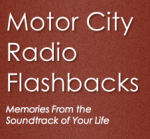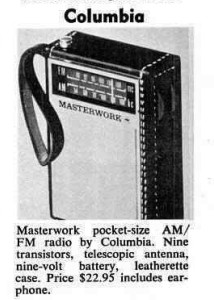 From the MCRFB NEWS archive: 1965
From the MCRFB NEWS archive: 1965
FM Radio Programming Drawing More Listeners’ Appeal In Most Major Markets
NEW YORK — The ability of radio stations to influence the sale of records is undergoing at present many changes. One of the most interesting facets is that FM stations are growing stronger — literally an explosive growth — in their ability to influence the sales of records, according the the latest Radio Response Ratings’ completed second cycle. They’ve long been strong in the merchandising of classical records and, to some extent, jazz, but now — as the use of FM receiver increases, the medium is also showing power in influencing the sale of rhythm and blues, popular music, and country music product.
As of June 1965, there were a total of 1,293 radio stations on the air, 41 more will soon go on the air (most of which may be currently broadcasting) and 207 had received Federal Communications Commission authorization and were under construction. These figures of the National Association of FM Broadcasters, Washington, indicates the fantastic increase in potential for exposing records over FM stations. As comparison, the NAFMB reports there were 1,191 FM stations as of January, 1965; 850 of these were owned by AM-licensed stations.
The recent order of the FCC requiring separate programming of a majority of the combination AM-FM stations — the deadline has been moved back to December 31 — should only do more to strengthening the effectiveness in FM exposure of records.
Billboard’s new Radio Response Ratings questionnaire now being mailed market-by-market to all major stations in 40 markets has been expanded to provide detailed FM data.

The Detroit market serves as a good example of the growth of FM radio. WGPR-FM, while ranking third in the influencing of R&B product, did account for 7 per cent of the total points in a July 17 Radio Response Rating survey — and this is against long-established AM stations. One reason for the success of the station, according to station manager Floyd M. Jones, is that some 87 per cent of the Negro population of Detroit has FM radios. In the country field, WBBM-FM accounted for 14 per cent of the total points against an AM station.
In Buffalo, station WBLK-FM is showing up strong in the influencing of R&B record sales — 33 per cent of the total votes.
WBLK-FM is also doing great runs with country music; the station is ranked third out of four stations that placed in the survey (all others were AM) and earned about 13 per cent of the votes.
Fort Worth, KXOL-FM ranked No. 2 in a field of several AM stations in influencing the sale of popular albums. The station scored 19 per cent of the votes. Both KODA-FM and KQUE-FM have a lot of strength in the popular LP field in Houston. In Miami, WEDR -FM controls 100 per cent of the sales of country music records, according to a Radio Response Rating survey of April 17, 1965.
A radio station in Oklahoma City, KFNB-FM, which also controls 10 per cent of the classical record sales, according to a recent Billboard survey, ranks fourth in influencing popular LP’s, achieving 16 per cent of the votes. KFOG-FM and KPEN-FM in San Francisco do fairly well in exposing popular LP’s; better, in fact, than another AM station there, although the main power lies in the reins of KSFO-Radio, an AM station.
In other markets not covered by the Billboard survey, FM stations are also doing rather well. For example, KAZZ-FM in Austin, Tex., programs many kinds of music to suit many tastes, including Top 40 records, folk, country, Latin American music, Broadway show cast albums, and jazz.
Rim Kelley, who programs KAZZ-FM’s Top 40 material recently told Billboard, “We have found that the Austin market is ready for FM Top 40. It’s fantastic the way our audience catches on. We have adults, even listeners in the 50-year-old bracket, who stay right with us through the Top 40 program. In fact, we get telephone requests from them now and then asking for a special number.”
KKOP-FM, Redondo Beach, Calif., also is programming out of the ordinary classical -jazz routine. Jack Paar, station manager, reported the station now plays a pop -jazz format. KMBC-FM, Kansas City, Mo., relies on a bright good music format, according to station director Chris J. Stolfa. Of course, FM stations are a mainstay in exposing classical and jazz records. Also, folk music records to some extent.
In Philadelphia, WPBS-FM recently pulled in 32,382 pieces of mail in a contest promotion. John McCall, production supervisor at the FM outlet, said, “Too often FM programming is not considered radio, but we at WPBS-FM challenge that concept. We advance radio. . . a new kind of radio, utilizing the best values of both AM and FM, providing the listener, the consumer, with entertainment, information, education, and sales messages in palatable amounts. “There’s a new breed of radio stations a growing, and WPBS is ahead of the pack.”
Team Effort Effective
One of the other major trends that seems to be growing is that the team disk jockey effort is proving highly effective in influencing record sales. A key part of the duo deejay effect with the audience -the element that gives them appeal -is often based upon comedy.
Sitting in the morning slot 6 -10 a.m. each day at WKYC-Radio, Cleveland, is the team of Harry Martin and Specs Howard. Publicity director Meirle Levin said the duo held a tremendous audience in the area because “they’re funny.” The team had been No. I in their category on Pulse survey for about two years, Levin said. Martin and Howard’s comedy routines include “The Drakeulas,” “Sponsor Place,” and “Congo Curt.” But, interspersed with the comedy skits, they play records. Although Joe Mayer of WHK-Radio gave them a close race, the team effort paid off with the No. 1 position in influencing popular single records in the morning spot.
Tim Nolan and Bob Byron of KPRC, Houston, also utilize humor and they ranked No. 1 in exposing and influencing the sale of popular LP’s there in a Billboard survey dated March 21, 1964. One of the farces that has made the team popular with their listeners was, for instance, a “More Snowplows” campaign. Every day – and there are not many – that the temperature drops below 60 degrees in Houston, they urge all listeners to picket City Hall for more snowplows. It snows about as often in Houston as it rains in the Sahara.
Gene Klavan and Dee Finch, of WNEW -Radio, are No. 1 in influencing the sale ofpopular LP’s in New York in the morning. Other duo deejay teams include Tommy Charles and Doug Layton of WAQY-Radio, Birmingham, Ala., who
ranked fourth in influencing the sale of popular singles in that area; Charlie Brown and Irving Harrigan of KLIF -Radio in Dallas, who not only topped the
list in influencing the sale of popular singles in the morning slot, but for the entire day and all popular single deejays, including other deejays on the KLIF-Radio staff who took second (Ken Dowe) and third (Jim Rabbit).
Then, down in New Orleans, Roy Roberts and Jeff Hugg of WSMB-Radio ranked No. 1 in influencing the sale of popular LP’s, a position also held by the station at Billboard’s May 8, 1965 survey.
Other data that will be included in the third cycle of Billboard’s survey includes how new records are selected, how many new records are played each week, including the selected station’s playlist information as well. END
___
(Information and news source: Billboard; August 7, 1965)
![]()

